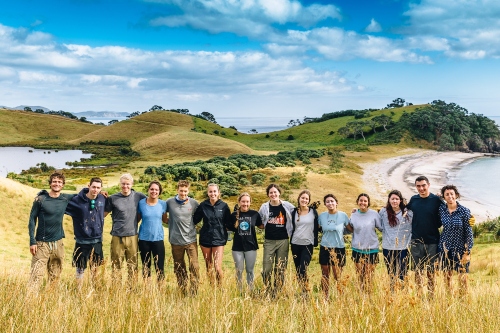Interested in finding out how to take a gap year after high school? Read on.
By the time you graduate from high school, you have spent an astonishing amount of time in the classroom and even more time studying and doing homework after school hours. No wonder that taking a gap year between high school and college is becoming an increasingly popular decision. But did you know that universities are also actively encouraging students to take a gap year?
We’ll tell you all about it, hold on tight! We will walk you through the benefits and the process of asking your college for a deferral, before handing you some tips for picking the right gap year program and having a seamless transition between your gap year and going back to college.
What is a gap year?
A gap year is a semester or year of experiential learning. Students will take a break from studying for a certain amount of time to pursue their other interests, dreams and passions. During this time, they learn more about themselves, their ambitions and the world around them.
There is no one right way to spend a gap year, it’s totally up to you! Some students want to earn a bit of money on an internship or work experience, others wish to discover new cultures and do volunteer work on a gap year program abroad.

Top benefits of taking a gap year after high school
1. You'll perform better in college
Gap year graduates tend to have higher GPA’s than students who did not take a gap year after high school, and they tend to graduate faster than the national average. This is not really surprising since gap year students have had more time to learn about their potential interests, meaning they are more likely to find a major that truly interests them. A study has even found that a staggering 60% of students felt that their gap year influenced their major.
2. Preventing an academic burnout
By the end of high school, you have spent most of your life behind a desk in a classroom, focusing on getting good grades and taking up extracurricular activities to impress potential colleges. Since this is the first time in your life that you are in the position to take a break and take the pressure off yourself, why not do just that? You will be able to focus on yourself for a year, avoid the danger of an academic burnout, and get back to college refreshed and refocused afterwards.
3. You'll make new friends!
You will have heaps of opportunities to meet new people and create lasting friendships during your gap year. If you choose to volunteer or live abroad for a while, you could gain friends from all over the world, and they will be stoked to offer you a couch to sleep on next time you want to visit their home towns.
If you choose to go on a gap semester program with an organization, you will spend an intense and exciting three months with a group of likeminded people and grow close bonds. Good friendships like these are hard to come by, often last a lifetime, and should not be underrated.

And this is just the tip of the iceberg. There are so many benefits of taking a gap year that we decided to write an entire article about them!
How to take a gap year after high school?
Step 1 - Reflect and think about your goals for the year
It all starts with knowing what you want to get out of taking a gap year. So take time to reflect about your reasons for taking a gap year and the best timing for it. Consider these questions and try answering them for yourself:
- Why do I want to take a gap year?
- What am I looking to learn, experience or achieve during my gap year?
- What is my budget? How will I finance my gap year?
- Do I want to take a full year off from academics, or is a semester enough to accomplish everything I want?
Step 2 - Talk to your family and friends
Your friends and family know you better than anyone else, and they might be able to give you insight and help you figure out what you should do during your gap year or what gap year program is best suited for you. Your parents might also get involved in paying for college and/or your gap year, so include them in the conversation and help them understand why this is the best path for you.
Step 3 - Research programs
There are many ways to spend your gap year, but gap year programs are one of the most popular choices. It’s not hard to see why! Students get to travel and volunteer abroad, while being in the safe hands of an experienced instructor that handles all the logistics for them. Gap year organizations like Pacific Discovery also have some long-standing community partners in place, making sure students get a unique experience and really immerse themselves in the local culture.
Do some research into the different gap year programs available and find the one that matches your goals the most. Pacific Discovery’s admissions team is always there to help students out and use their knowledge of the destinations and activities to find the perfect fit for them. When you are ready to sign up for this great adventure, begin an application here.

Step 4 - Prepare for the program
Once you have applied for a gap year program, Pacific Discovery will give you loads of information on how to prepare for the program. When to get your passport sorted, visit a health care professional and book your flights, just to name a few. You can also read books and watch movies that are set in your destination in order to mentally prepare, understand the culture better, and get excited of course!
Step 5 - Earn College Credits
Taking a gap year doesn't mean you have to take a full break from study. It might sound too good to be true, but you can actually get college credits for your gap year experience with Pacific Discovery through our partnership with two educational institutions. You can even contact your school of choice to transfer these credits over to them. Enrolling is simple and completely optional.
How do colleges view a gap year?
You might have been told that taking a gap year could have a negative effect on your future, or at the very least on your admission into college. We’d like to put that misconception to rest once and for all because, guess what, most colleges absolutely love it when students go on a gap year before they start college, and often encourage it!
Research shows that gap year students come back more mature, driven and prepared, so it’s really a win-win situation. Gap year students have also developed new skills, and statistics prove that they tend to perform better academically. Harvard University even attributes their 98% graduation rate to the fact that so many of their students take time off before or during college.
To make sure the college you're going to encourages deferrals as well, check out their gap year policy. The Gap Year Association keeps a record of the deferral policies of most universities in the United States to make things easy for you.

How to get a college deferral?
1. Look up the college deferral policy
Most colleges allow and even encourage gap years, but some don’t allow deferment and it’s best to know before applying. If you already have a preferred college in mind, have a look on their website to see what their gap year policy is, or check out a comprehensive list of American colleges and their deferral policies here.
If you can’t find any information online, the best plan of attack is to contact the admissions office of this college and just ask, framing it as a hypothetical question.
2. Apply to college
Just apply to colleges during senior year of high school, as if you weren’t planning on taking a gap year. You will have to go through the entire college application process like every other high schooler, and keep your fingers crossed you will get accepted to your dream college. Once you get in, you will have to pay the deposit to secure your space.
3. Request a deferral
Contact the college admissions office at your chosen college and ask for a deferral. A deferral is an agreement that the college will hold a spot for you, so you can come back after the agreed-upon timeline. Usually, you will also have to fill in a deferral form to confirm everything in writing.
Top Questions Answered About Taking a Gap Year After High School
1. Will I be behind after taking a gap year?
Absolutely not! It’s a fear many students bring up, because they will be a year older by the time they start college. But by the time they graduate, no one really cares about the age difference anymore.
Additionally, it’s a healthy choice to delay college and take time away from academics to recharge, while having the additional benefit of boosting your future academic career and resume. Let’s be honest, volunteering with animals in Costa Rica or helping a local community in Peru looks a lot better for employers than finishing college a year earlier.

2. Will it be hard to transition to college after a gap year?
Students usually transition quite easily into college after a gap year. They have been away from school for a while and are able to come back with a clear mind, knowing more than ever what they want to study and get out of their college experience. Transitioning into a life in the classroom is made easier when students take time in between traveling or working and the start of the academic year for some time with friends and family, and for time to reflect on what they’ve experienced and learned during their gap year.
3. How to find the right gap year program for me?
Pacific Discovery has a big range of gap year programs for high school graduates. We like to give every type of student a great option, which is why we have such a big diversity of destinations and activities.
The sun seeker can spend a gap semester by the beach in Hawaii, surrounded by palm trees. The outdoor enthusiast can go on some epic hikes through the Himalayas in Nepal. The animal lover can volunteer at an animal rescue center in Costa Rica or Thailand. And the thrill seeker can learn to scuba dive and go on a multi-day rafting journey in Central America.
The list goes on, so we decided to make the decision process as easy as possible for you. Just follow this 3-step process to find your perfect program in no time:
- Take the Program Quiz
- Request the Online Catalogue, which provides information about Pacific Discovery's values and program design, as well as program descriptions, testimonials and a comparison chart
- Book a call with one of our advisors. They know the ins and outs of each and every program, and know how to find the right program match for every student. No strings attached!
Discover more
- The benefits of taking a gap year
- Taking a gap year during college
- Should I take a gap year before medical school?
- 12 cool gap year ideas for students
- Taking a gap year before grad school: should you do it?
- Why you should consider volunteering abroad on your gap year
- Everything you'll ever need to know about planning your gap year
- How to Apply to College After a Gap Year
- What to do during a gap year in 2023


Leave a Comment
Your email address will not be published. Required fields are marked *